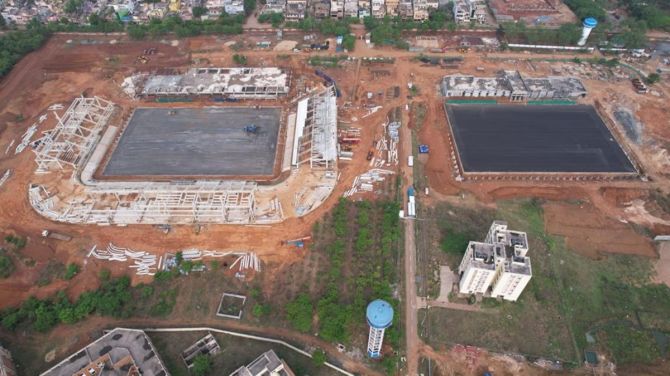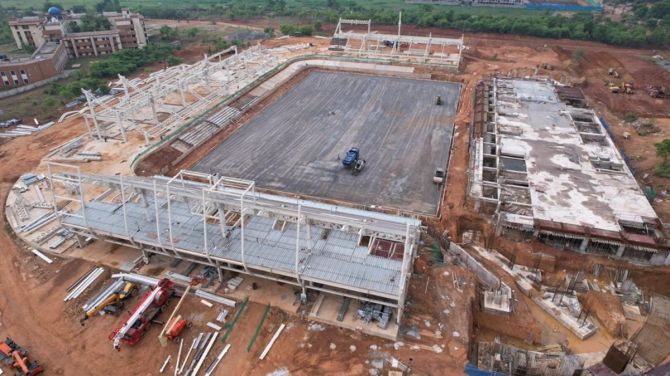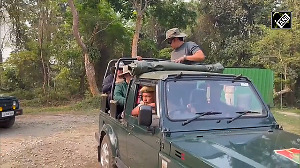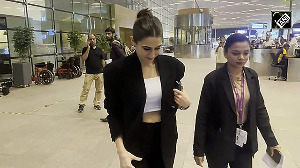
Cranes lifting heavy material, dusty roads leading up to the site, people in safety jackets and helmets doing their work amid heaps of sand and cement lying scattered all over the place.
There are ample signs that the construction of the country's largest hockey stadium is in full swing.
Come January next year, the Birsa Munda International Hockey Stadium in Odisha's tribal-dominated Sundargarh district will be packed to the rafters during the FIH Men's Hockey World Cup.
As many as 20,000 supporters will be rooting for the Indian hockey team, which is riding high on the Tokyo Olympics success and will seek to not only better the quarterfinal finish in the 2018 edition in Bhubaneswar, but also win the showpiece event.
The work at the stadium on the outskirts of Rourkela city started in June last year and it is going on round the clock as officials battle to complete it within the deadline.
Normally, it takes around 18-24 months to build a stadium of this size.
"But, we designed and planned it in such a way so that we can save time in engineering and the conventional construction part," Sports Department infrastructure consultant Swagat Singh said.
The executing agency of the 200-crore stadium is the Industrial Infrastructure Development Corporation of Odisha and it has sublet the work to the Larsen and Toubro.

The 80-crore accommodation near the practice pitch is being done by another contractor and its deadline is October, the official said.
The 35-acre site includes the stadium and accommodation inside the 120-acre campus of the Biju Patnaik University of Technology.
"It's India's largest hockey stadium. We're also assuming it to be the world's biggest, but yet to get that confirmation from the FIH," he told a group of journalists at the site, 293 km northwest of capital Bhubaneswar.
Singh exuded confidence of finishing the work in time by August.
"Almost 50-60 per cent of the work has been completed," he said.
The workforce size is around 400. The casting is done at night and preparatory work in the morning due to the searing heat for the past few weeks.
By the end of this month, the complete shell will be done. Once the skeleton structure is completed, the workers will start giving the finishing touch.
There are many USPs of this project, one of which is that it is a disabled-friendly stadium.
"In other stadiums, there are multiple floodlights, but we are integrating it within the building itself so that it won hamper the aesthetics," Singh said.
The colosseum-like structure is continuous, making it more functional in terms of viewing .
Singh highlighted that one will get a clear picture without any vision block no matter at what gallery or at which angle a spectator sits.
The field of play has a more run off area, the official said, expressing hope that it would host many World Cup matches, scheduling of which is yet to be done.
There will be some light projection and the facade has been designed in such a way that cultural aspects of the region can be integrated.
“Wall arts and murals will also be there. It will be an amalgamation of culture and heritage,” Singh said.
Just like the Hollywood Sign on Mount Lee in Los Angeles, the administration had planned to write Rourkela on the lush green and scenic Durgapur Hills, which overlooks and runs across one side of the stadium.
"But there are some technical and stability issues," Additional District Magistrate Subhankar Mohapatra said. "We're still trying tough."
Before the World Cup, the Fédération Internationale de Hockey (FIH) will certify whether it has complied to all the standards.
He informed that they are planning to hold for a Pro League in October-end that will act as a test event.
Post the World Cup, the government is mulling to convert the entire complex as an academy so that it remains a benchmark.
Sundargarh is regarded as the cradle of Indian hockey that has churned out that likes of Dilip Tirkey, Amit Rohidas and Birendra Lakra. From kids to the elderly, there's a lot of craze of the sport in the region.
That's why the state government wanted to have a footprint in the district because they wished to give it as a gift to the local population, Singh pointed out. "Many kids here prefer to hold a hockey stick instead of a cricket bat."












 © 2025
© 2025